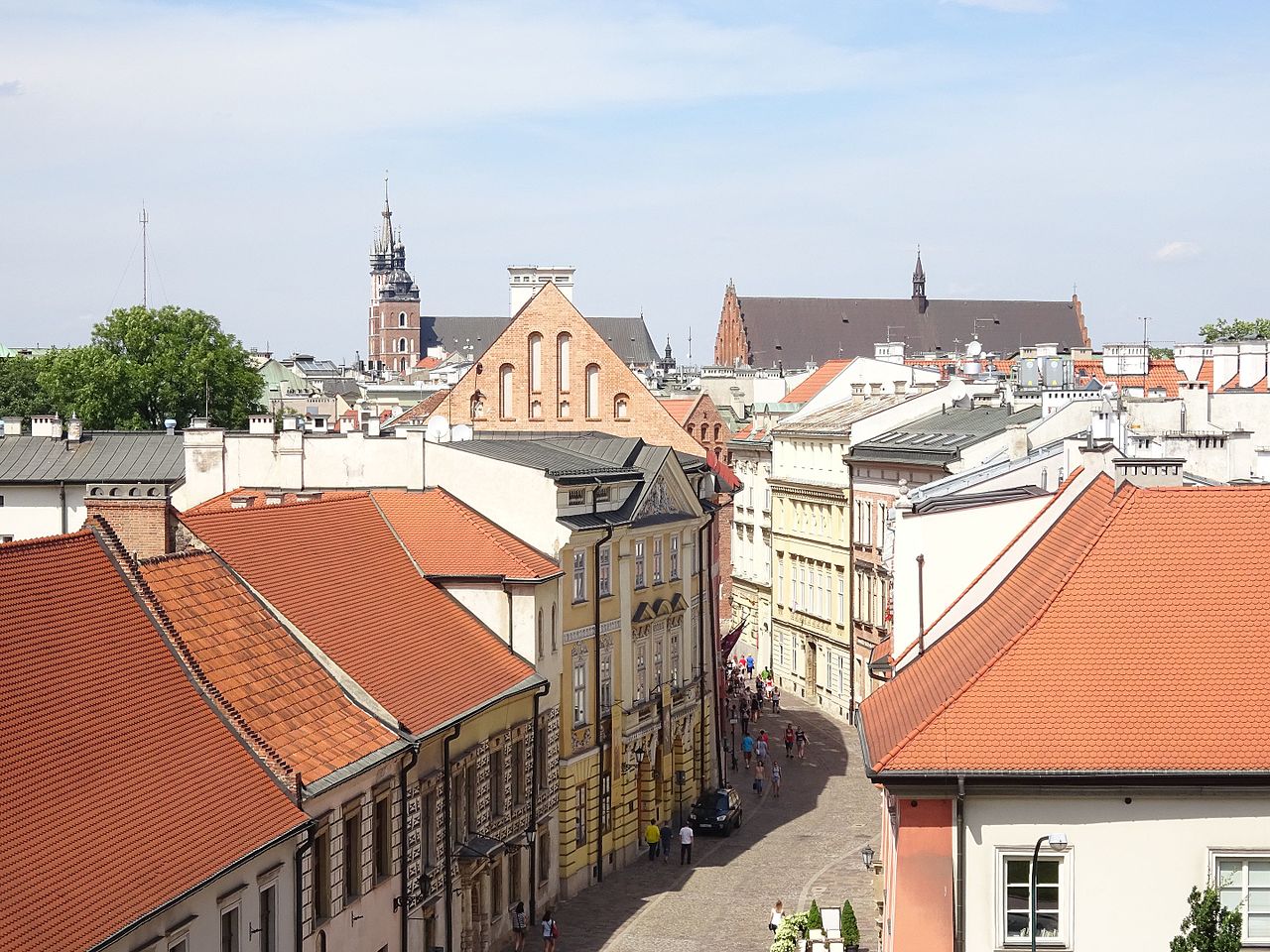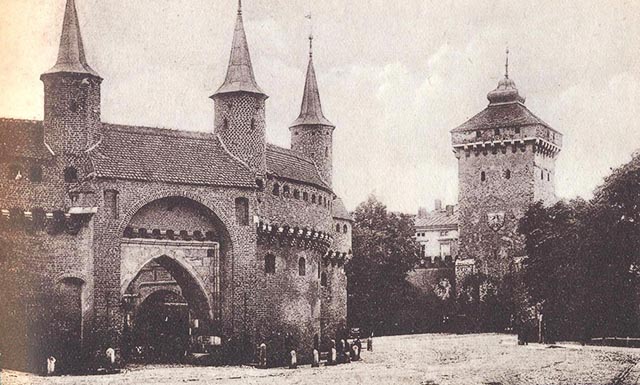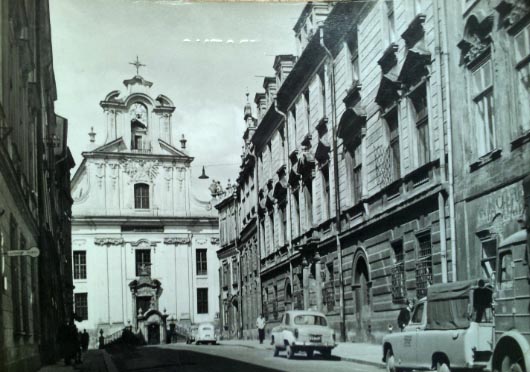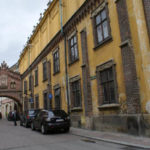 Ulica Kanonicza
Ulica Kanonicza
Prawdziwym klejnotem wśród ulic starego Krakowa jest Kanonicza, biegnąca równolegle do ul. Grodzkiej, po jej zachodniej stronie, od skrzyżowania z ul. Senacką aż do stóp Wawelu. Kanonicza ma swoje własne święto, podczas którego odbywają się tu liczne spotkania, prezentacje, przeciągają barwne korowody krakowskich mieszczan ubranych w renesansowe kostiumy. Czasy jej świetności przypadły na wiek XV i XVI, kiedy zamieszkiwali ją kanonicy katedry wawelskiej, i taki właśnie klimat – skupienia i skromności – zachował się do dnia dzisiejszego. Trwająca od lat konserwacja gotyckich i renesansowych domów odkrywa coraz to wspanialsze wnętrza, zakamarki, portale, herby i inne detale. Do najstarszych budynków należy Dom Kapitulny (nr 5) wybudowany w XV w. z przeznaczeniem na bursę studencką. Na fasadzie budynku widnieje herb Wieniawa należący do historyka Jana Długosza, który dom ten wybudował. Dziś przy Kanoniczej 5 funkcjonuje ośrodek dokumentacyjny działającego tu przed laty słynnego Teatru Cricot 2 Tadeusza Kantora.
Tadeusz Kantor, który zmarł w 1990 r.. byt wielkim rewolucjonistą i eksperymentatorem w dziedzinie sztuki teatralnej. Zdobył ogromny rozgłos w kraju i za granica. Z wykształcenia malarz, członek-założyciel Grupy Krakowskiej, uprawiał scenografie, reżyserie, happeningi. W 1956 r. założył niepowtarzalny i zjawiskowy teatr Cricot 2. Jeśli ktoś oglądał spektakle: Umarła klasa. Wielopole, Wielopole, Niech sczezną artyści czy też adaptacje sztuk Witkacego, zetknął się z magią szarych postaci aktorów i całej reszty kantorowsklch atrybutów „sztuki niemożliwej”, wśród których ważną role odgrywały rekwizyty – cała masa różnorodnych przedmiotów. Każdy kantorowski happening, każdy spektakl Cricot 2 z aktywnym udziałem samego reżysera, był zawsze poruszającym, zaskakującym i ponadrzeczywistym wydarzeniem artystycznym.
Po przeciwnej stronie, pod nr. 6, stoi bardzo nobliwie wyglądający Dom Rycerski z XIV w., wybudowany przez rycerza, kasztelana sandomierskiego – Hińczę z Rogowa. Po wielokrotnych przeróbkach budynek służy dziś Towarzystwu Przyjaciół Sztuk Pięknych. Kanonicza 7 to dom Pod Trzema Koronami z herbem kapituły krakowskiej „Trzy Korony”, z renesansową fasadą i z ponad sześćsetletnim rodowodem. Budynek jest obecnie siedzibą Stowarzyszenia Pisarzy Polskich. Zaraz obok, pod nr. 9, w wielokrotnie przebudowywanej kamienicy, przed którą rozpościera się pl. św. Marii Magdaleny, przed niespełna dwudziestu laty powstało Muzeum Stanisława Wyspiańskiego, gdzie zgromadzono eksponaty dokumentujące imponujący dorobek artystyczny autora Wesela.
Geniusz Stanisława Wyspiańskiego zawisł nad Krakowem pod koniec XIX w. i już na zawsze wtopił się w atmosferę miasta. Wyspiański, uważany za największą indywidualność polskiego symbolizmu, główną postać Młodej Polski, urodził się w 1869 r. i zmarł przedwcześnie w wieku 38 lat. Trudno określić, które z wielu zajęć uprawianych przez niego z równą pasją i żarliwością było najważniejsze: czy malarstwo, czy grafika, czy poezja, czy też dramatopisarstwo. We wszystkich tych dziedzinach Wyspiański osiągał równe sukcesy. Przyjaciele mówili o nim, że gdyby mu oddać świat do urządzenia, miałby gotowe pomysły na to, jak wszystko ma wyglądać. Niepowtarzalnym osiągnięciem Wyspiańskiego są witraże i polichromie (czysta kwiatowa secesja), które dzięki niemu (zob. np. kościół Franciszkanów) po raz pierwszy od czasów średniowiecza zdobyły rangę dzieł sztuki, i to światowej klasy. W muzeum znajduje się część obrazów, grafik i szkiców do witraży nigdy nie zrealizowanych. Udziałem Wyspiańskiego było odnowienie polskiej sztuki dekoracji książkowej, do której wprowadzi! modernistyczne elementy kwiatowe i folklorystyczne. W dziedzinie dramatu Wyspiański zasiada obok narodowych klasyków. Teatr traktował jako świątynię sztuki i stąd jego plany stworzenia amfiteatru na Wzgórzu Wawelskim. Z wielu dramatów, jakie napisał, do najsłynniejszych należą: Legenda, Warszawianka, Noc Listopadowa, Wyzwolenie, Akropolis, no i Wesele – wielki dramat symboliczny, oparty na realiach epoki Młodej Polski.
Jeszcze w czasach średniowiecza wybudowano Dom Szreniawa (nr 15), na fasadzie którego widnieje herb Szreniawa. Dziś mieści się tu Fundacja św. Włodzimierza (chrzciciela Rusi Kijowskiej), czyli tzw. Dom Ukraiński. Następny budynek (pod nr. 17) nazywany Domem Zygmuntowskim, który powstał w XIV w., był niegdyś pałacem biskupa Erazma Ciołka. W portalu znajduje się herb Zygmunta Augusta, a po jego prawej stronie można dojrzeć ciekawostkę architektoniczną: gotyckie okienko w typie zwanym ukośnym lub uchylnym – dzięki takiej konstrukcji przepuszczające więcej światła dziennego. Kolejny na tej ulicy Dom Kapitulny, stojący pod nr. 19, za elegancką klasycystyczną fasadą kryje wnętrza Muzeum Archidiecezjalnego.
Na rogu ul. Kanoniczej i ul. Podzamcze, skąd doskonale widać majestat północnego skrzydła zamku wawelskiego, pod nr. 25 zachował się Dom Długosza o ciekawej tradycji. Niegdyś nazywano go Łaźnią Jagiełły, bo podobno kąpiącego się tu króla podglądali panowie polscy, chcąc ustalić, czy szczegóły anatomicznej budowy Jagiełły sprostają wymogom dynastycznym. W połowie XV w. mieszkał tu i tworzył Historię Polski Jan Długosz, a od 1873 r. miał tu pracownię rzeźbiarz Franciszek Wyspiański – ojciec Stanisława.
Od strony ul. Podzamcze na wysokości I piętra widnieje XVII-wieczny wizerunek Madonny z Dzieciątkiem, który został ostrzelany albo przez Szwedów, albo przez Rosjan i stąd ślady po szesnastu kulach. Napis z początku XVI w. nad bramą tłumaczy się następująco: Nie ma nic lepszego w człowieku niż rozum i z takim też przekonaniem podchodzimy pod Wawel.






